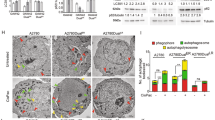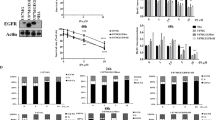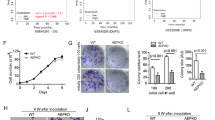Abstract
Targeting the autophagic process is considered a promising therapeutic strategy in cancer since a great number of tumors, including melanoma, show high basal levels of protective autophagy that contributes to tumor progression and chemoresistance. Here, exploiting both in vitro and in vivo approaches, we identified N6-isopentenyladenosine (iPA), an end product of the mevalonate pathway, as a novel autophagy inhibitor with an interesting anti-melanoma activity. iPA, after being phosphorylated by adenosine kinase into 5′-iPA-monophosphate, induces autophagosome accumulation through AMPK activation, measured by increased fluorescent GFP-LC3 puncta and enhanced conversion into the lipidated autophagosome-associated LC3-II. However, at a later stage iPA blocks the autophagic flux monitored by p62 accumulation, Luciferase reporter-based assay for LC3 turnover in living cells and fluorescence of a tandem RFP-GFP-LC3 construct. Impaired autophagic flux is due to the block of autophagosome–lysosome fusion through the defective localization and function of Rab7, whose prenylation is inhibited by iPA, resulting in a net inhibition of autophagy completion that finally leads to melanoma apoptotic cell death. AMPK silencing prevents apoptosis upon iPA treatment, whereas basal autophagosome turnover is still inhibited due to unprenylated Rab7. These results strongly support the advantage of targeting autophagy for therapeutic gain in melanoma and provide the preclinical rational to further investigate the antitumor action of iPA, able to coordinately induce autophagosome accumulation and inhibit the autophagic flux, independently targeting AMPK and Rab7 prenylation. This property may be particularly useful for the selective killing of tumors, like melanoma, that frequently develop chemotherapy resistance due to protective autophagy activation.
Similar content being viewed by others
Log in or create a free account to read this content
Gain free access to this article, as well as selected content from this journal and more on nature.com
or
References
Garbe C, Eigentler TK, Keilholz U, Hauschild A, Kirkwood JM . Systematic review of medical treatment in melanoma: current status and future prospects. Oncologist 2011; 16: 5–24.
Lawrence MS, Stojanov P, Polak P, Kryukov GV, Cibulskis K, Sivachenko A et al. Mutational heterogeneity in cancer and the search for new cancerassociated genes. Nature 2013; 499: 214–218.
Hodi FS, Chesney J, Pavlick AC, Robert C, Grossmann KF, McDermott DF et al. Combined nivolumab and ipilimumab versus ipilimumab alone in patients with advanced melanoma: 2-year overall survival outcomes in a multicentre, randomised, controlled, phase 2 trial. Lancet Oncol 2016; 17: 1558–1568.
Polkowska M, Czepielewska E, Kozłowska-Wojciechowska M . Drug combinations as the new standard for melanoma treatment. Curr Treat Opt Oncol 2016; 17: 61.
Redman JM, Gibney GT, Atkins MB . Advances in immunotherapy for melanoma. BMC Med 2016; 14: 20.
Welsh SJ, Rizos H, Scolyer RA, Long GV . Resistance to combination BRAF and MEK inhibition in metastatic melanoma: where to next? Eur J Cancer 2016; 62: 76–85.
Green DR, Levine B . To be or not to be? How selective autophagy and cell death govern cell fate. Cell 2014; 157: 65–75.
Choi AM, Ryter SW, Levine B . Autophagy in human health and disease. N Engl J Med 2013; 368: 651–662.
White E . The role for autophagy in cancer. J Clin Invest 2015; 125: 42–46.
Liu H, He Z, Simon HU . Targeting autophagy as a potential therapeutic approach for melanoma therapy. Semin Cancer Biol 2013; 23: 352–360.
Ma XH, Piao S, Wang D, McAfee QW, Nathanson KL, Lum JJ et al. Measurements of tumor cell autophagy predict invasiveness, resistance to chemotherapy, and survival in melanoma. Clin Cancer Res 2011; 17: 3478–3489.
Bifulco M, Malfitano AM, Proto MC, Santoro A, Caruso MG, Laezza C . Biological and pharmacological roles of N6-isopentenyladenosine: an emerging anticancer drug. Anticancer Agents Med Chem 2008; 8: 200–204.
Yang J, Zhang J, Huang Z, Wang Z, Zhu Q, Liu L . Correlation of cytokinin levels in the endosperms and roots with cell number and cell division activity during endosperm development in rice. Ann Bot 2002; 90: 369–377.
Laten HM, Zahareas-Doktor S . Presence and source of free isopentenyladenosine in yeasts. Proc Natl Acad Sci USA 1985; 82: 1113–1115.
Gillman EC, Slusher LB, Martin NC, Hopper AK . MOD5 translation initiation sites determine N6-isopentenyladenosine modification of mitochondrial and cytoplasmic tRNA. Mol Cell Biol 1991; 11: 2382–2390.
Spinola M, Galvan A, Pignatiello C, Conti B, Pastorino U, Nicander B et al. Identification and functional characterization of the candidatetumor suppressor gene TRIT1 in human lung cancer. Oncogene 2005; 24: 5502–5509.
Moustafa ME, Carlson BA, El-Saadani MA, Kryukov GV, Sun QA, Harney JW et al. Selective inhibition of selenocysteinetRNA maturation and seleno protein synthesis in transgenic mice expressing isopentenyladenosine-deficient selenocysteinetRNA. Mol Cell Biol 2001; 21: 3840–3852.
Laezza C, Notarnicola M, Caruso MG, Messa C, Macchia M, Bertini S et al. N6-isopentenyladenosine arrests tumor cell proliferation by inhibiting farnesyl diphosphate synthase and protein prenylation. FASEB J 2006; 20: 412–418.
Laezza C, Caruso MG, Gentile T, Notarnicola M, Malfitano AM, Di Matola T et al. N6-isopentenyladenosine inhibits cell proliferation and induces apoptosis in a human colon cancer cell line DLD1. Int J Cancer 2009; 124: 1322–1329.
Laezza C, Malfitano AM, Di Matola T, Ricchi P, Bifulco M . Involvement of Akt/NF-κB pathway in N6-isopentenyladenosine-induced apoptosis in human breast cancer cells. Mol Carcinog 2010; 49: 892–901.
Castiglioni S, Casati S, Ottria R, Ciuffreda P, Maier JA . N6-isopentenyladenosine and its analogue N6-benzyladenosine induce cell cycle arrest and apoptosis in bladder carcinoma T24 cells. Anticancer Agents Med Chem 2013; 13: 672–678.
Casati S, Ottria R, Baldoli E, Lopez E, Maier JA, Ciuffreda P . Effects of cytokinins, cytokinin ribosides and their analogs on the viability of normal and neoplastic human cells. Anticancer Res 2011; 31: 3401–3406.
Spinola M, Colombo F, Falvella FS, Dragani TA . N6-isopentenyladenosine: a potential therapeutic agent for a variety of epithelial cancers. Int J Cancer 2007; 120: 2744–2748.
Scrima M, Lauro G, Grimaldi M, Di Marino S, Tosco A, Picardi P et al. Structural evidence of N6-isopentenyladenosine as a new ligand of farnesyl pyrophosphate synthase. J Med Chem 2014; 57: 7798–7803.
Pisanti S, Picardi P, Ciaglia E, Margarucci L, Ronca R, Giacomini A et al. Antiangiogenic effects of N6-isopentenyladenosine, an endogenous isoprenoid end product, mediated by AMPK activation. FASEB J 2014; 28: 1132–1144.
Høyer-Hansen M, Jäättelä M . AMP-activated protein kinase: a universal regulator of autophagy? Autophagy 2007; 3: 381–383.
Farkas T, Høyer-Hansen M, Jäättelä M . Identification of novel autophagy regulators by a luciferase-based assay for the kinetics of autophagic flux. Autophagy 2009; 5: 1018–1025.
Kimura S, Noda T, Yoshimori T . Dissection of the autophagosome maturation process by a novel reporter protein, tandem fluorescent-tagged LC3. Autophagy 2007; 3: 452–460.
Kawai A, Uchiyama H, Takano S, Nakamura N, Ohkuma S . Autophagosome-lysosome fusion depends on the pH in acidic compartments in CHO cells. Autophagy 2007; 3: 154–157.
Hyttinen JM, Niittykoski M, Salminen A, Kaarniranta K . Maturation of autophagosomes and endosomes: a key role for Rab7. Biochim Biophys Acta 2013; 1833: 503–510.
Ciaglia E, Abate M, Laezza C, Pisanti S, Vitale M, Seneca V et al. Antiglioma effects of N6-isopentenyladenosine, an endogenous isoprenoid end product, through the downregulation of epidermal growth factor receptor. Int J Cancer 2017; 140: 959–972.
Ciaglia E, Pisanti S, Picardi P, Laezza C, Malfitano AM, D'Alessandro A et al. N6-isopentenyladenosine, an endogenous isoprenoid end product, directly affects cytotoxic and regulatory functions of human NK cells through FDPS modulation. J Leukoc Biol 2013; 94: 1207–1219.
Ciaglia E, Pisanti S, Picardi P, Laezza C, Sosa S, Tubaro A et al. N6-isopentenyladenosine affects cytotoxic activity and cytokines production by IL-2 activated NK cells and exerts topical anti-inflammatory activity in mice. Pharmacol Res 2014; 89: 1–10.
Tang DY, Ellis RA, Lovat PE . Prognostic impact of autophagy biomarkers for cutaneous melanoma. Front Oncol 2016; 6: 236.
Høyer-Hansen M, Jäättelä M . Autophagy: an emerging target for cancer therapy. Autophagy 2008; 4: 574–580.
Corazzari M, Fimia GM, Lovat P, Piacentini M . Why is autophagy important for melanoma? Molecular mechanisms and therapeutic implications. Semin Cancer Biol 2013; 23: 337–343.
Lazova R, Camp RL, Klump V, Siddiqui SF, Amaravadi RK, Pawelek JM . Punctate LC3B expression is a common feature of solid tumors and associated with proliferation, metastasis, and poor outcome. Clin Cancer Res 2012; 18: 370–379.
Yang ZJ, Chee CE, Huang S, Sinicrope FA . The role of autophagy in cancer: therapeutic implications. Mol Cancer Ther 2011; 10: 1533–1541.
Rangwala R, Leone R, Chang YC, Fecher LA, Schuchter LM, Kramer A et al. Phase I trial of hydroxychloroquine with dose-intense temozolomide in patients with advanced solid tumors and melanoma. Autophagy 2014; 10: 1369–1379.
Zhao X, Fang Y, Yang Y, Qin Y, Wu P, Wang T et al. Elaiophylin, a novel autophagy inhibitor, exerts antitumor activity as a single agent in ovarian cancer cells. Autophagy 2015; 11: 1849–1863.
Gutierrez MG, Munafó DB, Berón W, Colombo MI . Rab7 is required for the normal progression of the autophagic pathway in mammalian cells. J Cell Sci 2004; 117: 2687–2697.
Dykstra KM, Allen C, Born EJ, Tong H, Holstein SA . Mechanisms for autophagy modulation by isoprenoid biosynthetic pathway inhibitors in multiple myeloma cells. Oncotarget 2015; 6: 41535–41549.
Miettinen TP, Björklund M . Mevalonate pathway regulates cell size homeostasis and proteostasis through autophagy. Cell Rep 2015; 13: 2610–2620.
Li M, Yang Z, Vollmer LL, Gao Y, Fu Y, Liu C et al. AMDE-1 is a dual function chemical for autophagy activation and inhibition. PLoS ONE 2015; 10: e0122083.
Chi KH, Wang YS, Huang YC, Chiang HC, Chi MS, Chi CH et al. Simultaneous activation and inhibition of autophagy sensitizes cancer cells to chemotherapy. Oncotarget 2016; 7: 58075–58088.
Hardie DG . AMP-activated/SNF1 protein kinases: conserved guardians of cellular energy. Nat Rev Mol Cell Biol 2007; 8: 774–785.
Kim J, Kundu M, Viollet B, Guan KL . AMPK and mTOR regulate autophagy through direct phosphorylation of Ulk1. Nat Cell Biol 2011; 13: 132–141.
Xie X, White EP, Mehnert JM . Coordinate autophagy and mTOR pathway inhibition enhances cell death in melanoma. PLoS ONE 2013; 8: e55096.
Maiuri MC, Zalckvar E, Kimchi A, Kroemer G . Self-eating and self-killing: crosstalk between autophagy and apoptosis. Nat Rev Mol Cell Biol 2007; 8: 741–752.
Amodio G, Venditti R, De Matteis MA, Moltedo O, Pignataro P, Remondelli P . Endoplasmic reticulum stress reduces COPII vesicle formation and modifies Sec23a cycling at ERESs. FEBS Lett 2013; 587: 3261–3266.
Acknowledgements
This study was supported by Associazione Italiana per la Ricerca sul Cancro (AIRC) and Fondazione Cariplo (AIRC TRIDEO 2015 No. 17216 to SP) and by AIRC (IG No. 13312 and No. 18999 to MB). We thank Dr. Donatella Fiore for technical support in animal care.
Author information
Authors and Affiliations
Corresponding authors
Ethics declarations
Competing interests
The authors declare no conflict of interest.
Additional information
Edited by H-U Simon
Supplementary Information accompanies this paper on Cell Death and Differentiation website
Supplementary information
Rights and permissions
About this article
Cite this article
Ranieri, R., Ciaglia, E., Amodio, G. et al. N6-isopentenyladenosine dual targeting of AMPK and Rab7 prenylation inhibits melanoma growth through the impairment of autophagic flux. Cell Death Differ 25, 353–367 (2018). https://doi.org/10.1038/cdd.2017.165
Received:
Revised:
Accepted:
Published:
Issue date:
DOI: https://doi.org/10.1038/cdd.2017.165
This article is cited by
-
NRP1 instructs IL-17-producing ILC3s to drive colitis progression
Cellular & Molecular Immunology (2025)
-
A potential strategy for bladder cancer treatment: inhibiting autophagy to enhance antitumor effects of Nectin-4-MMAE
Cell Death & Disease (2024)
-
MicroRNA-mediated autophagy and drug resistance in cancer: mechanisms and therapeutic strategies
Discover Oncology (2024)
-
Regulation of autophagy by protein lipidation
Advanced Biotechnology (2024)
-
The roles of METTL3 on autophagy and proliferation of vascular smooth muscle cells are mediated by mTOR rather than by CDK1
Cell Division (2023)



